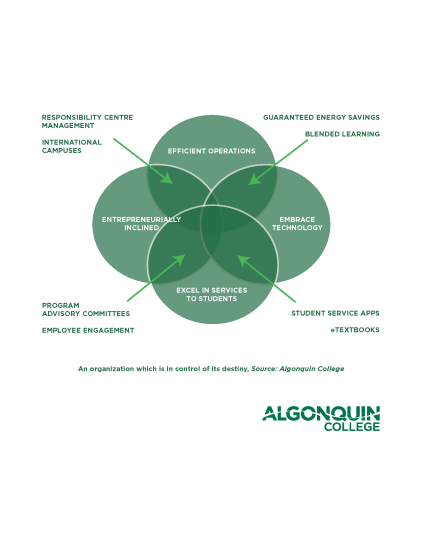 Mature higher education markets are drifting headfirst into the perfect storm. The convergence of shifting demographics, increased competition, decreased government funding and the reality of a global marketplace has become our new normal here in Canada, like in many other parts of the world. Most within the academy have come to accept this reality, and so the question is not if this storm will come ashore but rather, what will be done to navigate through it when it does.
Mature higher education markets are drifting headfirst into the perfect storm. The convergence of shifting demographics, increased competition, decreased government funding and the reality of a global marketplace has become our new normal here in Canada, like in many other parts of the world. Most within the academy have come to accept this reality, and so the question is not if this storm will come ashore but rather, what will be done to navigate through it when it does.
As costs escalate and revenues deteriorate, one response is to apply the tried and true method of cost control—that is to cut. This approach is easy to understand. Everyone feels some pain and there is a belief that the institution will muddle through until we once again see clear skies beyond the horizon.
Yet, what if there are no blue skies in the near future? What if this traditional approach to confronting costs results in death by a thousand cuts, or at least ill health for years ahead? This belief led us to ask: Might there be a better way?
Our answer is a resounding yes, and our 4E Model is a Framework that guides us forward. This model (see figure below) is based upon the fundamental belief that we must control our own destiny; that it is not government that must serve as our travel guide (whether through regulation or funding), but rather it is the institution’s responsibility to navigate this storm before us. In our experience, there are four distinct practices we believe colleges and universities can use to navigate through turbulent times.

Entrepreneurially inclined
Higher education institutions must embrace the opportunity to be masters of their own destiny. To do so requires them to be entrepreneurially inclined. We know North American higher education is in demand around the world. The world wants what we have, and at our institution, we have been moving toward a more entrepreneurial, decentralized culture.
There are several examples of our entrepreneurial inclinations, including the work we do internationally. We have recruited international students for years, but within the last three years, we have made a conscious decision to expand our presence in emerging markets like Saudi Arabia and Kuwait through offshore campuses. While we democratize higher education in these markets, we are reinvesting millions of earned revenue back into our underfunded domestic operations.
Empowering our employees is a critical component of being an entrepreneurially oriented organization. How we recruit, hire, train and retain entrepreneurial employees helps define our success. This inclination to be entrepreneurial is liberating—it pushes us to greater heights and frees us to have more control over our own fate.
Efficient operations
Finding efficiency in operations is critical. To accomplish this, we have implemented regular, systemic reviews of our operations, including a Strategic Process and Services Planning (SPSP) review process to measure how our operations are delivering relevant, quality and cost-effective programs and services. This SPSP review, available as a case study for purchase through the Harvard University Press, reflects our commitment to the process of continuous review and improvement. The culture of continuous improvement we have created through SPSP resulted in changes both large and small; most importantly, it has paved the way for future changes.
How our services are delivered has also become a more efficient process. We apply lean management practices to cross-college processes to eliminate duplication and enhance service delivery. Delivering more efficient and higher-value operations means not having to simply apply across-the-board cuts. Rather, it means services can be delivered faster, cheaper and better. An example can be found in our Counselling Services department. Giving our students the ability to book same-day appointments, while also limiting their ability to book appointments more than two weeks in advance, has decreased our wait times while increasing the number of students accessing this valuable and important service—all without the need to add more staff.
We also recognized that having potential students who were unsuccessful in their admissions test wait a year until the program came around again was not efficient. We have since changed that process, so potential students who were unsuccessful in the test can retake the test, and we can then offer them a spot in other programs if they are still not successful. This has meant retaining 780 more students per year at little or no cost to us. As an access institution that firmly believes education is the greatest tool you can use to change the world, this type of change speaks directly to our identity as an organization and the benefits speak for themselves.
Embracing technology
High-performing institutions eagerly embrace technology as a way of stabilizing higher education’s iron triangle of access, quality and cost. We have saved tens of millions of dollars in the past decade by integrating technology into the learning environment. Today, we accommodate 3,000 more full-time students every year than the physical space on our main campus should allow. We have done this by implementing mandatory online learning in all full-time programs where 20% of all learning in every full-time program is now online.
Most recently, our eTextbook initiative means more than 100 programs will be free of paper textbooks by the fall. Leveraging this technology means enhanced learning resources for students while reducing what these students spend on textbooks by over $2 million annually. Another example is our relationship with Siemens Canada. Our guaranteed energy savings partnership. known as ESCO 2, will accrue millions of dollars in energy savings and yield enhanced learning facilities for our students—facilities that we would not have had otherwise. Siemens provided needed upgrades and renovations to our facilities that will generate energy and water savings, and the college will be repaying Siemens from the savings generated. The size and scale of this agreement is what makes this agreement so significant—the college was able to address tens of millions of dollars in deferred maintenance through ESCO 2, and we will save $3.7 million from our energy and water bills annually at the conclusion of the agreement.
Excel in service to students
Universities and colleges provide a variety of student services. What is necessary is to have a culture that is in service to students. Cost-conscious colleges know that students must be served throughout their higher education journey—from application to enrollment to retention to graduation and, ultimately, to their careers and back again. From the signs on our walls reminding staff they are “Here 2 Help,” to something as simple as having all staff wear nametags, being purpose-driven toward the cause of student success aligns our organization’s behavior with the needs of those it is meant to serve: the students.
A commitment to a full lifecycle approach to service ensures the success of nontraditional students. The concept of “in service to our students” includes fulfilling the expectation that the education they receive will lead to employment. Maximizing our students’ chances after graduation means more than simply providing them with the skills and training we think they need; it means being self-critical and hearing firsthand from their future employers about their expectations for our graduates. We think this unabashed commitment to serve students has an impact on recruitment and the retention of our students.
There will be increased and complex challenges facing all higher education institutions in the coming years. Some organizations will wait and wail–hopeful that someone in government will arrive to fix these problems. We believe organizations that are ready to confront the changes on their own will be the ones most able to persevere and rise above their competitors. These are the institutions that understand the “new normal” is the “new way” forward and that simply cutting costs is a short-term solution with few long-term benefits.
Kent MacDonald is president of Algonquin College in Ottawa, Ontario. Phil Gaudreau is the communications officer for the college.
[ssba]
